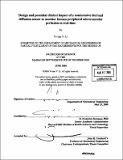| dc.contributor.advisor | H. Frederick Bowman. | en_US |
| dc.contributor.author | Li, Vivian V. (Vivian Victoria) | en_US |
| dc.contributor.other | Massachusetts Institute of Technology. Dept. of Mechanical Engineering. | en_US |
| dc.date.accessioned | 2007-03-12T17:48:54Z | |
| dc.date.available | 2007-03-12T17:48:54Z | |
| dc.date.copyright | 2006 | en_US |
| dc.date.issued | 2006 | en_US |
| dc.identifier.uri | http://hdl.handle.net/1721.1/36735 | |
| dc.description | Thesis (S.B.)--Massachusetts Institute of Technology, Dept. of Mechanical Engineering, 2006. | en_US |
| dc.description | Includes bibliographical references (p. 79-89). | en_US |
| dc.description.abstract | Perfusion in peripheral tissues is fundamental to the characterization of both local and global cardiovascular health. However, despite the inherent accessibility of tissues such as skin to microvascular measurements, there is still a need for routine, noninvasive methods for obtaining relevant assessments of the human microcirculation. Human microvasculature includes the arterioles, capillaries, and venules that supply tissues with nutrients, circulate humoral products, and remove waste. The process of circulatory distribution is an efficient and highly structured process that distributes output through a regulation of local and global mechanisms that match blood flow to tissue need. These mechanisms are still not fully understood, but they do indicate a practical and potentially valuable connection between coronary and peripheral vascular function. Current methods of measuring perfusion in a reliable way are invasive, involve complicated procedures, do not permit continuous data collection, and are relatively expensive. The design of a noninvasive perfusion monitoring system that can routinely and continuously monitor perfusion in accessible tissues such as skin would have significant potential in applications requiring an understanding of the microvasculature as well as its diagnostic potential in a variety of circulatory disease states including (but not limited to) atherosclerosis, ischemic events, and wound healing ability. | en_US |
| dc.description.statementofresponsibility | by Vivian V. Li. | en_US |
| dc.format.extent | 89 p. | en_US |
| dc.language.iso | eng | en_US |
| dc.publisher | Massachusetts Institute of Technology | en_US |
| dc.rights | M.I.T. theses are protected by copyright. They may be viewed from this source for any purpose, but reproduction or distribution in any format is prohibited without written permission. See provided URL for inquiries about permission. | en_US |
| dc.rights.uri | http://dspace.mit.edu/handle/1721.1/7582 | |
| dc.subject | Mechanical Engineering. | en_US |
| dc.title | Design and potential clinical impact of a noninvasive thermal diffusion sensor to monitor human peripheral microvascular perfusion in real-time | en_US |
| dc.type | Thesis | en_US |
| dc.description.degree | S.B. | en_US |
| dc.contributor.department | Massachusetts Institute of Technology. Department of Mechanical Engineering | |
| dc.identifier.oclc | 77564583 | en_US |
